R C Edition
August 4, 2025

August 4, 2025
By ROC Edition Staff
A virtual town hall meeting held last Monday gave Ocean Pines residents a platform to raise questions and voice concerns on the proposed construction of a monopole in the Ocean Pines Golf Course’s maintenance yard. This project aims to solve the community’s network coverage gaps in certain parts of the community. During the meeting, residents asked a variety of questions regarding what areas will benefit the most and even offered some suggestions to modify the plan.
The July 28 meeting was coordinated by Milestone Towers, the wireless infrastructure developer currently handling the early stages of the monopole project, and had representatives from Verizon, one of the three prospective carriers, present.
In the virtual meeting, one common theme among many of the residents’ questions was whether the monopole would effectively improve coverage for the general area or just for its immediate surroundings. One resident who posed this question was Chief Tim Robinson of the Ocean Pines Police Department who looked at the proposal from a safety perspective, seeing poor coverage as negatively affecting communication between first responders and the public.
A representative of Verizon, Paul Plymouth addressed the police chief’s concern, assuring him that the tower is expected to significantly enhance coverage and also alleviate current network congestion.
“The network (in Ocean Pines) right now is so congested that putting in that tower just makes things a lot better in that general area … and while there’s still going to be some congestion, and there are some ways we can deal with that congestion, there’s going to be a lot bigger impact for the general area,” Plymouth said.
Fawad Ali, a radio frequency engineer also representing Verizon,
expanded on Plymouth’s point, saying that when people see “SOS” on their phones, it is not necessarily due to a lack of coverage; it is sometimes the case that the nearby towers have hit their maximum capacity and cannot connect new users. With the proposed monopole having Verizon, AT&T and T-Mobile as carriers, this will no longer be an issue, according to Ali.
Despite the representatives promising better coverage, certain residents raised concerns about the tower’s visibility. The intention of the monopole’s designers is to camouflage the tower as a pine tree so it is not as noticeable; however, many Ocean Pines residents believe the
See CELL TOWER page 3

By Sherrie Clifford ROC Edition Publisher
A brand-new, Amish-built gazebo was installed this past week at the Ocean Pines Dog Park, adding both charm and practical shelter for dog owners who frequent the popular Manklin Meadows facility. While the park is already shaded by mature trees, the gazebo offers a central, covered space where visitors can gather during light rain, enhancing both the aesthetics and functionality of the space.
Located across from the Racquet Sports Complex, the softball field and the Manklin Meadows playground, the fenced-in park provides a safe and social environment for pets and their owners. It includes two separate areas: one for large dogs, and the other for small to medium-sized dogs or those that are shy or more mild-mannered.
Many regulars meet daily, with some arriving as early as 7 a.m. to catch up while their dogs roam and play. Though the new gazebo does
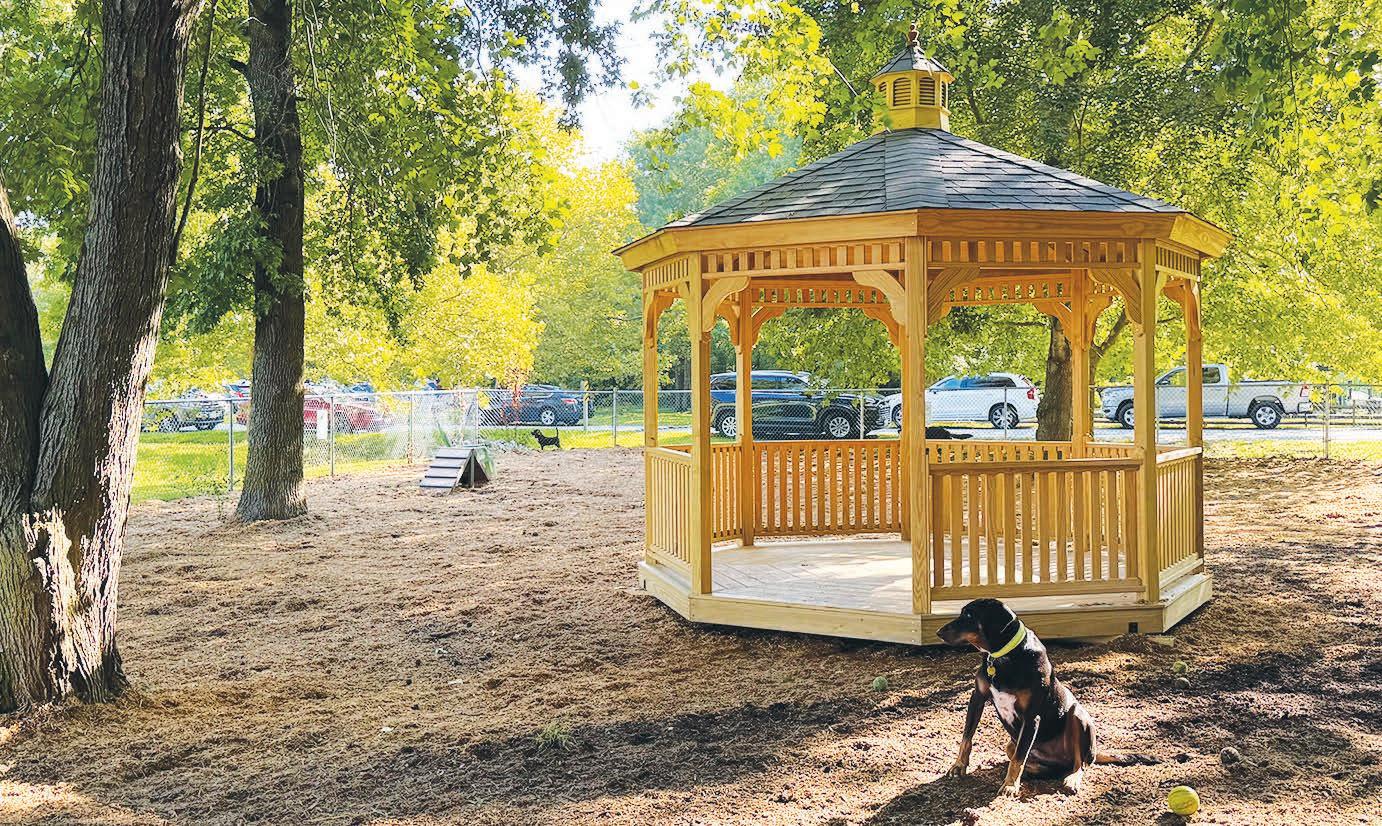
not yet include benches, there are plenty of movable chairs within the park that can be shifted beneath the structure for coverage and comfort.
The small dog area was recently upgraded with fresh wood chip mulch to help reduce mud and
puddling during wet weather. The large dog area remains in need of similar improvements, and park visitors hope to see that addressed soon.
The gazebo reflects the community’s ongoing commitment to
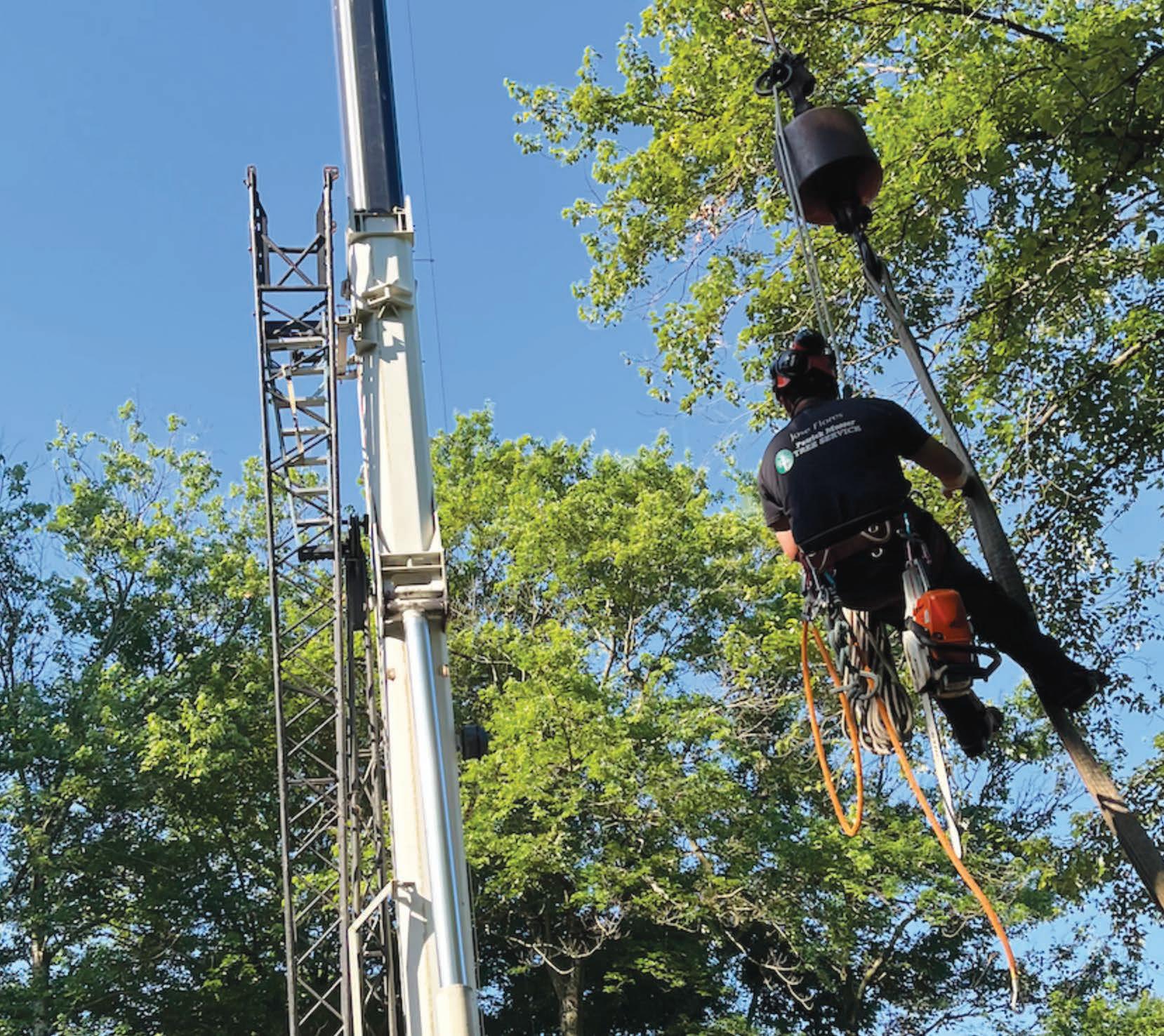
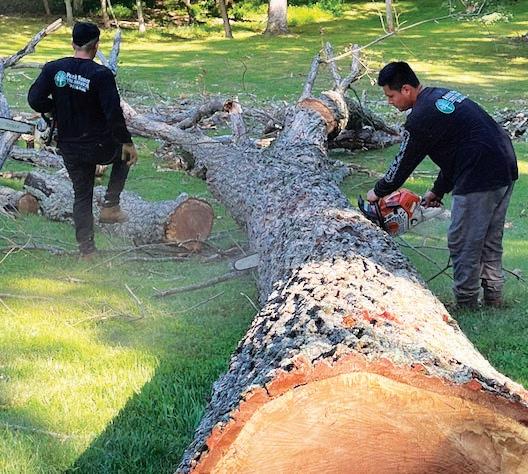

ROC Edition • Sherrie Clifford, Publisher
Ocean Pines Public Works Department installs new mailbox cluster in Wood Duck Isle at a cost of $72,519.
By ROC Edition Staff
The Ocean Pines Public Works Department has completed the installation of new mailboxes at the cluster located between Wood Duck I and Wood Duck II.
The project began with the disassembling of the old mailboxes on Monday, July 7. The following week, on July 15, a new concrete pad was poured, and blacktopping work took place on July 22 and 23. On July 24, the new mailboxes were assembled and set in place. The project, as a whole, had a price tag of $72,519,
Continued from page 1
150-foot telecommunications tower will still be conspicuously visible. It is due to this that Ocean Pines resident David Tanner raised another frequently asked question: Why construct a large, 150-foot cell tower when you can simply install multiple smaller cell towers, known as small cells, that are less intrusive visually?
“From the Verizon perspective, why not put in these small cells like you have in other communities that are less objectionable from an aesthetic point of view and also can go where we actually got service problems,” Tanner said.
To this, Plymouth explained that towers are optimal for extending cell coverage across a large region, while small cells are only useful for covering smaller areas. The biggest setback for simply installing multiple small cells in Ocean Pines is all the trees in the area, which would affect the cells’ already short coverage distances.
Multiple residents attending, however, were very enthusiastic about the prospective construction. One resident, in fact, stated the
according to the July 26 Board of Directors meeting.
The final step will be for the U.S. Postal Service to assign individual boxes, a process residents have been told will be done in roughly two weeks. Mail delivery will resume once this process is completed.
This installation is part of Ocean Pine’s community-wide effort to replace the area’s mailboxes, which the Ocean Pines Association owns. The replacement of the mailboxes located at Cannon Drive is projected to begin sometime in September, for a total cost of $25,933.
community should go even further and eliminate the poor coverage entirely with a so-called “holistic approach.” The resident suggested they should build the big tower to cover the large region and utilize small cells to target the stubborn, low-connectivity regions.
Although this case was not discussed in regards to AT&T and T-Mobile, Paul Plymouth answered on behalf of Verizon’s circumstances.
“Both towers and small cells are quite a big financial investment for any carrier to make … The tower is going to be the most appropriate first step … We always start with building out the tower, and if for any reason, there’s some other areas that need that additional coverage and capacity, then we’ll look at what the next step is going to be,” Plymouth said. If it becomes necessary, he added, they could use small cells down the line to augment capacity in conjunction with the tower.
With the meeting now concluded, the next steps for Milestone Towers remain to bring the project forth to the Board of Directors for approval and go to Worcester County to apply for zoning.



Continued from page 1
enhancing public spaces and maintaining a welcoming environment for residents.
According to the Ocean Pines Recreation and Parks Department, memberships for the dog park run from May 1 through April 30 and are available through that department at 235 Ocean Parkway. Registration requires proof of current vaccinations, including rabies, and a signed “Acceptance of Risk and Release of Liability Waiver Form.” Once approved, members receive a color-coded dog tag and a key card that unlocks the park’s electronic gate during scheduled hours. Passes are non-transferable and must be renewed annually. Replacement key cards are available for a $5 fee.
The park features a double-gated entry for safety and posted rules to ensure a respectful environment. Dogs must remain leashed until inside the first gate. Aggressive dogs, female dogs in heat and puppies under four months old are not permitted. Owners must clean up after their pets, supervise them closely and carry a leash at all times.
No more than two dogs per person are allowed in the off-leash area and children under 10 must be accompanied by an adult. Smoking, running, outside treats and feeding other dogs are prohibited. Owners are also asked to fill in any holes their dogs dig and to leave rawhide chews and favorite toys at home.
The Ocean Pines Dog Park is monitored by the Recreation and Parks Department and patrolled by Ocean Pines Police when needed. In the event of a dog bite or safety concern, residents are encouraged to contact police at 410-641-7747 or call 911 in an emergency.
Thanks to the vision and active involvement of Ocean Pines resident Jack Levering, along with continued support from local leadership, the dog park remains a well-used and well-loved space for residents and their four-legged companions.
For more information or to register a dog for access, visit the Ocean Pines Community Center or call the Recreation and Parks Department at 410-641-7052.
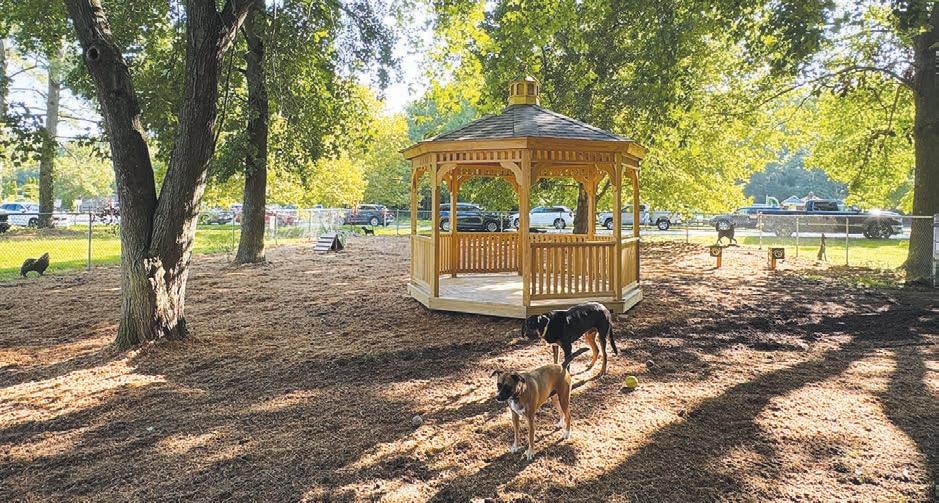



By ROC Edition Staff
As the 2025 Board of Directors election winds down, some Ocean Pines residents are raising concerns about an increasingly negative tone in online discourse, one they say is silencing open dialogue and deterring qualified individuals from participating in community leadership.
What once resembled spirited political debate on social media has, over time, given way to more coordinated, aggressive and personal attacks. Posts increasingly focus on discrediting individuals rather than discussing ideas. The targets have ranged from current election candidates to former board
members, volunteers and residents who voice independent or reformminded views.
In many instances, online exchanges have included namecalling, foul language and sarcastic personal jabs. Even routine policy disagreements are sometimes met with ridicule or belittling commentary. Residents say the rhetoric often crosses the line from disagreement into hostility, particularly during the election cycle.
While the reach of these posts remains limited to a small online audience, their impact borders on and, in some cases, crosses into defamation. Certain residents report being mocked, falsely accused or harassed online. Others say they
have chosen to disengage from community involvement out of concern for their reputations or personal well-being.
This environment, while driven by a small number of participants, contributes to a broader culture of fear and exclusion, some have suggested. It has made it more difficult to recruit volunteers for committees or to encourage participation, key elements of a healthy and representative homeowners association.
Voting in the 2025 Ocean Pines Board of Directors election is currently coming to a close. Ballots have been mailed to property owners and online voting is being conducted through ElectionBuddy. com, managed by MK Elections
of Pittsburgh, Pennsylvania. Final results are expected on Aug. 8, followed by the Annual Meeting on Saturday, Aug. 9.
As the community looks ahead, many hope to move beyond division and toward a more inclusive and civil discourse, one that encourages participation, honors differences and respects those willing to serve.
Editor’s Note: This article intentionally omits the name of the group and individuals involved to avoid amplifying or drawing further attention to behavior that many in the community find harmful. The goal is to inform and encourage a healthier dialogue, not to escalate division or target specific residents.
By ROC Edition Staff
Two months into its new fiscal year, the Ocean Pines Association (OPA) is reporting a favorable operational variance of $126,000, according to the general manager’s report for the period ending June 30, 2025. Total year-to-date revenues are slightly ahead of budget, with several departments outperforming projections and others holding steady.
Combined, the figures place net year-to-date operations at
approximately $1.6 million in the black, a positive outcome driven by strong amenity performance and continued cost control across departments.
OPA General Manager John Viola has credited improved financial oversight, strong amenity use and steady community support for helping the association maintain fiscal stability.
Amenity-based departments such as Food and Beverage, Aquatics, Recreation and Parks, and Golf all contributed to the favorable
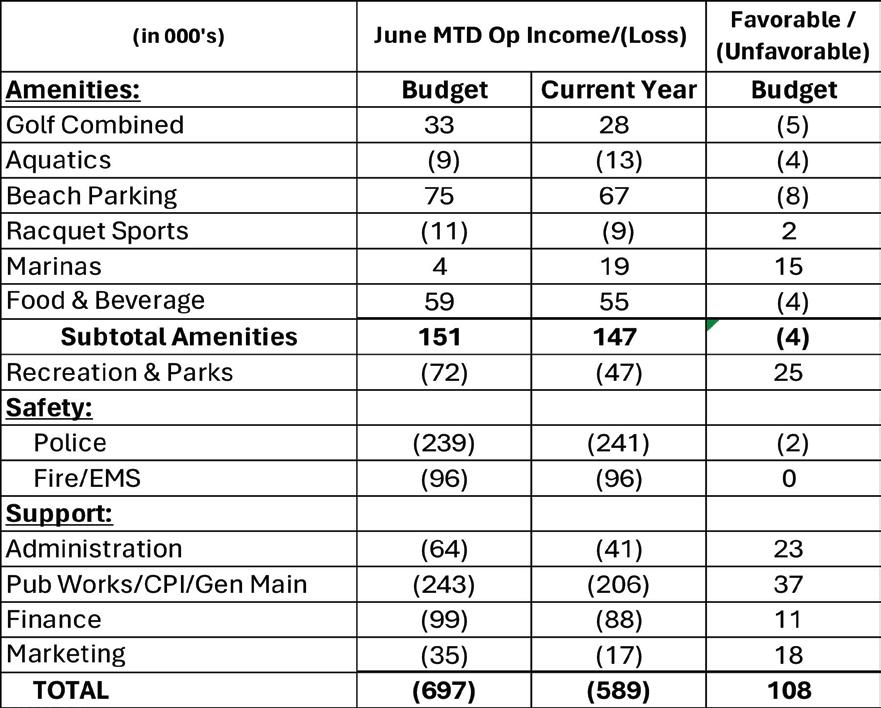
variance. Several operations are outperforming their projected revenue targets while maintaining or reducing spending levels.
The update arrives just weeks before the association’s Annual Meeting on August 9, where members will hear financial updates and meet newly elected Board members. Budget planning for the next fiscal year is also expected to begin this fall.
While the financial results remain unaudited, the report reflects a continuation of positive trends seen
in recent years. Association officials say the strong early-year outlook may offer flexibility in addressing upcoming capital needs or long-term maintenance priorities.
A visual summary of key financial figures including revenues over budget, expenses under budget and overall operational surplus is included in this edition.
For ongoing updates, residents are encouraged to visit the Ocean Pines Association website at www.oceanpines.org.

By Giovanni Guido Staff Writer
It has been roughly a decade since the idea of a comfort station at Stephen Decatur Park was first proposed to the Berlin Town Council. At its most recent meeting, the council unanimously agreed to award Henley Construction funding to build the public restroom facility, despite the contractor requiring roughly $58,000 more than the town obtained in funding. To make up for this shortfall, the governing body agreed to allocate two months’ worth of funds from the town’s slots revenues.
This future 225-square-foot facility will include “two restrooms, a maintenance room and a drinking fountain,” according to the staff report that was submitted to the council.
“This project aims to significantly enhance public outdoor recreation access in Berlin by supporting existing park amenities … The comfort station is designed to meet accessibility standards and accommodate the longterm service needs of residents and visitors,” the report read.
Believing the project’s cost would be much lower, the town garnered funding in the amount of $266,000; $133,000 from the Land and Water Conservation Fund grant, $99,000 from the Community Parks and Playgrounds Program grant and a final $34,000 match from the town. This would have covered the entire cost of the project as it was originally estimated to be; however, the original estimate of the project was done in March 2024, making the number outdated. When a request for proposals was sent out earlier this year to hire a contractor for the project, the lowest bid was $290,320 from Henley Construction. And this amount was only for the construction portion of the project; an additional $34,000 would be needed for the engineering and design. This amounted to a total of $324,320, resulting in a shortfall of $58,320.
At its July 28 meeting, the governing body looked into three strategies to close the financial gap, all of which were presented to them by the town’s financial director, Natalie Saleh.
To begin, Saleh described to the Mayor and Council the first option. This proposed the allocation of two months’ worth of slots revenues, which they receive from Ocean Downs Casino. These two months of revenue would add up to a total of $59,000. The second option was to reallocate the funds for the fence installation at Henry Park to the public facility project. This option, however, would only amount to $55,000. To reach the amount they need, the town would have to reallocate $4,000 from certain contracted engineering services in its general fund, in addition to the reallocation of the fence funds. The third and final option proposed to the body was to dip into the town’s general fund contingency, which has sufficient funding to cover the $59,000.
Saleh stated the council could go ahead with any of these options but emphasized that this project needs to be set in motion, since it has been in the works for roughly a decade.
When proposed these three options, the Mayor and Council unanimously agreed that they would prefer to go ahead with the first of the three
options and use the slots revenues to make up for the shortfall.
Mayor Zack Tyndall stated that he thinks the fence installation should receive its proper funding, and the amount from the general fund would be better used toward the town’s comprehensive plan. He thus suggested the council approve the use of the slots revenues.
Councilman Jack Orris was also in favor of the first strategy but wanted to ensure there were no other obligations the town was under that would need the money from the slots revenues. His main concern was in regards to the funding of the Law Enforcement Officer’s Pension System, which receives funds from the town’s slots revenues.
Saleh assured the councilman that no such thing would be occurring.
With that, the council unanimously approved the use of slots revenues in the amount of $59,000 to cover the entirety of Henley Construction’s bid, allowing the contractor to go ahead with the project.

By Giovanni Guido Staff Writer
Roughly 30 residents of the Town of Berlin attended the most recent Mayor and Council meeting to make the governing body aware of the need for sidewalks on a certain stretch of Old Ocean City Boulevard. With so many residents making an appearance, the council did not want to leave them empty-handed. The members of the council agreed to take a step toward construction of the sidewalk by getting an estimate on how much the project would cost and a survey of the land to see how feasible the project is.
Although many residents are now speaking of the sidewalk problem, this issue is not new. For quite some time, the town officials have been aware of the lack of sidewalks along the road and have advocated for their construction. Despite the efforts by the council, however, the town has remained in practically the same place in regards to the sidewalk project. The seemingly minimal progress exhibited by the town has
led residents to speak at the July 28 council meeting in hopes of getting this project further along.
The first citizen to address the council was Dirk Widdowson who is a resident of Purnell Crossing, a neighborhood just off Old Ocean City Boulevard. In preparation for his comments, Widdowson did some research into the importance sidewalks serve in a community.
“Sidewalks serve a critical role in enhancing pedestrian safety by physically separating pedestrians from vehicle traffic … Streets without sidewalks are more than twice as likely to have driver-pedestrian crashes compared to streets with sidewalks. Providing walkways separated from travel lanes can prevent up to 88% of walking-along-roadway crashes,” Widdowson said.
Also a resident of Purnell Crossing, Matthew Stoehr spoke of his own experience advocating for sidewalks on the street in question as the chairman of the town’s Planning Commission.
“I’ve been speaking on these sidewalks for five or six years now, since
I got on the Planning Commission. I ride my bike down that road two or three days a week … There are a lot of distracted drivers on that road … We are going to hit a place where someone gets hit and we’re going to be reacting to it instead of trying to get ahead of this … I just really want to emphasize that I understand budgets are tight … But for five or six years now, we’ve been waiting for this thing to get through … So, I’m just asking that you guys start looking at how Berlin can, unfortunately, pony up and help us with our 75 plus townhouses,” Stoehr said.
Once again, another Purnell Crossing resident, Vanessa Stein, addressed the governing body along with her son and daughter to talk of their experience on the road.
Stein’s son spoke to the council about his experience riding bikes along the road with his sister.
“When we ride our bikes down here to get ice cream, and since there’s no sidewalks, there’s a bigger risk of us getting hit by a car. And I’d rather not get hit,” the boy said simply.
of the road’s margins.
“We can, moving forward, figure out how much it’ll cost to engineer and then move forward with Berlin, being prepared to find the funding. We’ll have to talk about that. But I would hope that there is impact fee funding, at least for the engineering study, so at least we can move forward in some sort of direction,” Green said.
When asked about the impact fee fund, Financial Director Natalie Saleh told the council she did not have an exact number of the fund’s balance at that time but knew it was a little below $1 million.
Town resident Widdowson agreed with Green’s idea and addressed the council once more to tell the members they should take the initiative and not wait for the state.
“In my opinion, the wait-and-see is the very, very wrong plan for what you should do … We can get the survey, we can determine whether there is easements, we can determine whether we need to get an easement. But that doesn’t get done until we do it, and I’m asking you all to do it and not put this off,” he said.

Stein then elaborated on her son’s point. “The drivers are so distracted and even when we’re coming back, we’ve almost gotten hit because they’re just not paying attention, whether they’re on their phones or whatever else is happening. There’s times when I’m teaching them you can’t just trust that they’re going to do what they’re supposed to do; you always have to be alert … So, I think those sidewalks will definitely help safety,” Stein said.

Mayor Zack Tyndall told the residents that the town has the cooperation of the state for this project, but there is one main problem they have encountered which is delaying the project’s progress: The lack of consistent easements along the south side road. To put sidewalks beside a road, there, of course, needs to be enough space to place them; that is, large enough easements. And the mayor said that, according to the state, there is not enough of a margin along the road to set the sidewalks in. “That’s been the hold up with the project,” he added.
The entire council was in agreement with the residents who spoke and did not want to send them home with just empty promises. With that in mind, Councilman Steve Green said the town should take matters into its own hands by taking steps to progress the project themselves. One step he suggested was conducting an engineering study to survey the land
The governing body unanimously decided to take the first step in Green’s idea by getting an estimate of how much the engineering study would cost. Once they have an estimate, the council will most likely dip into its impact fee funds to pay for the study, which will determine the size of the easements and the owners of the properties.
This engineering study, however, is not possible without the permission of all the homeowners who have a property that would be scrutinized to see if there is a sizable enough easement.
Town Administrator Mary Bohlen then suggested the town email all the property owners to ask for their permission and cooperation. But she did add that the council should know the size of the easements that are necessary for the sidewalks, information which they should be able to obtain from the state, she said.
“It’s a big difference between going to a property owner and saying we need 5 feet or we need 10 feet. So, we kind of need to figure out what we have first,” Bohlen said.
With that, the mayor thanked all the residents who attended the meeting to express the need for a sidewalk on Old Ocean City Boulevard and stressed that their concerns were “not falling on deaf ears.”
By Giovanni Guido Staff Writer
Two motions were passed by the Berlin Town Council to encourage more people to use the new parking lot at the corner of West and Washington Streets. The first motion approved the use of funds from Berlin’s development impact fees for improvements of the parking lot; the second was the designation of certain areas of West and Washington Streets as “no parking” zones. Both of these motions aim to address recent concerns about accessibility and safety regarding the excessive number of cars parked on either side of those streets.
For the parking lot improvements, the council unanimously approved the allocation of $75,000 from the development impact fees to the town’s general fund. With this amount being transferred to the general fund, the town will then be able to finance the parking lot improvements. The council members told the public, these improvements will include the installation of both fencing and parking blocks.
In January, the Mayor and Council came to an agreement with the Esham family, the owners of the plot that now acts as a parking lot. This agreement was made to deal with accessibility issues, as certain parts of Berlin were difficult to reach due to the high volume of cars parking on the sides of streets. With this issue also came concerns of safety. Town officials and many residents believed that the congested streets would lead to difficulty for emergency vehicles to get to where they need to be. The Mayor and Council’s solution to this was entering into a 10-year lease agreement with the Esham family to designate the plot on the corner of West and Washington Streets as a parking lot.
Despite the additional parking spaces, people have continued to park on the sides of those two streets, which has led the council to make certain parts of them no parking zones.
Councilman Steve Green told the council he witnessed many cars parked on the street during the weekly Berlin Farmers Market, even though there were many open spaces in the new parking lot.
“I (counted) 28 cars parked from the parking area that’s allowed on West … It just proves the point that we have to do it if we want people off the street for public safety

After designating new parking lot on the corner of West and Washington Streets, the Berlin Town Council takes measures to ensure streets are no longer congested with parked cars by establishing multiple “no parking” zones.
reasons and to increase the usage of the lot. If we don’t do it, it’s going to continue to happen, and it’s going to continue to spill into other areas,” Green said.
For West Street, the motion would classify the road from Main Street to Evans Road on the west side as a no parking zone. This would then make both sides of the road a designated no parking zone. The west side of Washington Street would also be classified as a no parking zone from West Street to Broad Street.
Regarding the no parking zone on West Street, Councilman Jack Orris relayed to the council an alternative that was suggested to him by a town resident.
“A resident did reach out and offer a suggestion that the no parking on both sides of West stop at West Buckingham Road instead of going all the way down to Evans. The reasoning behind that was, in their view, parking doesn’t seem to be that much of an issue down there because it’s a little bit further of a walk to the town center,” Orris said.
To this suggestion, Police Chief Arnold Downing explained why he felt that alternative would not be advantageous to the town compared to the proposed motion.
“Sidewalks are coming. Sooner or later, we need to go ahead and focus toward that. But when you’re parking, you are actually almost halfway into the driving portion. Right now, on that side, I only see one vehicle regularly parked there … But we should be consistent all the way down the street,” Downing said.
The council passed the motion, as it was originally proposed, unanimously. However, the no parking
zone designation will not go into effect until the town has secured the proper signage that would state which areas prohibit parking. Once the signs are put in place, the police will then be able to enforce the rule. Violators of the rule could get their vehicles towed.
Mayor Zack Tyndall pointed out to the public that people are able to
ask for an exemption which might allow a person to park in the designated no parking zones. People must email mayorzack@berlinmd.gov, the mayor and his assistant’s shared inbox, to ask for an exemption. The mayor stated those requests will be evaluated on a “case-by-case basis.”


In any homeowners association (HOA), trust is the foundation of effective governance. That trust is easily fractured, not only by policy disagreements or divisive decisions, but by deeper issues surrounding conflicts of interest and the lack of a formal, enforceable code of ethics for board members.
It’s time for communities across the country to face this problem head-on.
HOA boards often oversee millions of dollars in budgets, award contracts, manage community assets and make decisions that affect property values and residents’ daily lives. With that level of authority comes the responsibility to operate under clear ethical standards, and yet many boards do not have a formal code in place. That’s not just an oversight. It’s a risk.
Conflicts of interest aren’t always overt or financial. Sometimes they take the form of subtle favoritism, personal relationships, business ties or political loyalties that go undisclosed. When board members make decisions that affect vendors, committee appointments or neighborhood disputes while having private connections to those involved, residents deserve full transparency. And when that transparency is lacking, the integrity of the entire board comes into question.
Many HOA communities have witnessed the consequences: closed-door dealings, questionable appointments, vague budget explanations and perceptions of behind-the-scenes influence. Even the appearance of impropriety erodes public trust, and, without a formal code of ethics, there’s little structure to prevent that erosion.
A robust code of ethics does more than safeguard the community, it protects the board members themselves. It offers clear guidance, sets public expectations and provides a framework for recusals when impartiality is compromised. It also signals to homeowners that decisions are being made with fairness, not favoritism.
Some argue that “good intentions” and “common sense” are enough, that board members can govern ethically without needing a written document. But informal good faith is no substitute for structured governance. In complex communities managing large budgets and legal liabilities, ethical standards must be defined, not assumed.
Every board should require members to disclose potential conflicts and abstain from any votes or discussions where personal interests may interfere. More importantly, every HOA should adopt a public, written code of ethics that outlines expected behavior, transparency standards and consequences for violations.
This is not about targeting individuals. It’s about raising the standard for governance across all HOA communities. A well-run board should welcome these standards, viewing them not as obstacles but as tools for earning and keeping the community’s trust.
If a board member is unwilling to disclose their personal or financial ties to matters under board review, the community has every right to ask why. Homeowners deserve clarity. They deserve protection from favoritism. And they deserve to know their elected board is working in the interest of all, not a select few.
Trust is not automatic. It is built and protected through transparency, consistency and ethical leadership. If HOAs want to serve their communities effectively, they must stop treating ethics as optional.
Anything less puts everyone at risk.
Sherrie Clifford Publisher, ROC Edition
Sherrie Clifford Publisher/Editor 856-873-6029 sclifford@oceanpinesroc.com
Staff Consultant News Editor editor@oceanpinesroc.com
Giovanni Guido Staff Writer gioguido56@gmail.com
Roger Marino Columnist marino.roger@aol.com
Lara Spaid Advertising Sales 410-443-4717 laraspaid@comcast.net
Too often, people are made to feel invisible as they grow older, judged, dismissed or silenced by those who don’t understand their journey. But your worth doesn’t expire. And it certainly isn’t for others to define. Whether you’re starting over, speaking up or finally doing what you have always wanted, this is your life, and it deserves to be lived on your terms.
Too many of us spend our days waiting.
We wait for the perfect time to start something new, for permission to take a risk, for the right job to show up, the relationship to feel secure, the money to be “enough” or the fear to go away. We wait for someone else to notice our efforts or for a sign that tells us it’s safe to move forward. We convince ourselves we are just being cautious, when in reality, we have built a life around delay.
But here’s the truth: Life doesn’t wait. Time moves with or without our consent. And while we are busy waiting, life is being lived not by some future version of ourselves, but by the version that exists today, in this moment.
Living, truly living, means stepping into the uncertainty. It means accepting that there may never be a perfect time, that risk is part of the deal and that courage is not the absence of fear; it’s the decision to act in spite of it. It means showing up fully, even when the outcome is not
guaranteed. Especially when it isn’t. We don’t need more time. We need more intention.
There’s a reason people feel stuck. It’s easier to wait than to take responsibility. It’s more comfortable to complain than to commit. It’s safer to dream than to do. But that comfort comes at a cost. The cost is joy, momentum and purpose. We numb ourselves with distractions, excuses and routines, telling ourselves that tomorrow will be different, that we will start after the holidays or once things settle down.
But what if they never do?
There is nothing wrong with planning, but there is a fine line between planning and postponing. We say we are waiting for clarity, but sometimes clarity only comes through action. We want guarantees, but growth comes with messiness. Living means taking the trip now, writing the book now, reaching out now, forgiving now, speaking up now, even when it’s scary. Especially when it’s scary.
And sometimes what’s truly scary is not failure; it’s being seen. It’s knowing that when you stand up and live boldly, someone will try to tear you down. Not everyone will understand or support your voice. Some will lie, distort, degrade or gossip because they feel threatened by anyone willing to do what they are too afraid to try. They will attack not because you are wrong, but because you are brave. Their

fear will show up as cruelty. Their weakness will wear the mask of judgment. But make no mistake: It is not your duty to stay silent to keep them comfortable.
You must live anyway.
It’s easy to think we are the only ones afraid. That others have it all figured out. But everyone is afraid. Everyone has doubts. What separates those who live from those who wait is not talent or luck. It’s the willingness to move forward anyway.
Some people live decades this way, not fully unhappy but not fully alive either. They follow the rules, meet expectations, keep the peace. They become experts at waiting for change, for relief, for happiness until the waiting itself becomes their life story.
But the story can change.
It changes the moment we decide to stop waiting to be chosen and choose ourselves. It changes when we let go of who we thought we had to be and start honoring who we are.
It changes when we stop delaying joy until everything is “fixed” and allow ourselves to be present, even in the unfinished places.
There will always be reasons not to start. There will always be people who doubt you, including yourself. There will always be fear of failure, rejection, judgment or loss. But there will not always be time.
This life can be messy, unpredictable and beautiful, but there is one thing that is certain: This life is not a rehearsal. It is not a holding pattern. It is not something that begins once you check all the boxes. It’s happening now.
So live. Say what needs to be said. Do the thing you have been thinking about. Don’t wait to feel ready, because readiness is often a myth. Move forward anyway. Because in the end, we will not regret living. We will regret waiting.
Sherrie Clifford Publisher, ROC Edition

Dear Editor:
I watched the “town meeting” last night and found it interesting and highly educational. Thanks to OPA management for arranging the broadcast.
I found the presentation confusing. Firstly, the tower dude was trying to present a lot of network information, while the Verizon reps were on the sidelines until they were called in. When the Verizon reps spoke, I thought they were ill-prepared.
If that was supposed to be a technical briefing, it provided lots of data and not much information. If it was supposed to be a sales pitch (which I think was the intention), they presented confusing and barely legible graphics.
Heat maps for antenna patterns are used by technical people as a basis for analysis. Showing an illegible heat map to the general public is unhelpful and confusing. At least the presenters were candid when they said that the heat map cannot be correlated to “bars” on a cell phone. One has to wonder why the heat maps were presented in this
meeting at all.
I was glad to see the presenters address the two challenges of cell networks:
Capacity – how many simultaneous “conversations” can a cell nexus support, and
Connectivity – the likelihood of connecting when desired, and the quality of the connections.
Notwithstanding advertising claims, a cellular network is a probabilistic domain. Given adequate signal strength between a cell transceiver and a phone or tablet, a quality connection is probable but not certain. When the signal is degraded by factors like distance, foliage, steel objects, etc., the probability of a solid connection is decreased.
It appears to me that Verizon’s primary objective in this effort is to increase the network capacity on Route 90. Connectivity benefits to OPA residents are desirable but secondary to the main objective.
Here are my conclusions from the presentation:
Verizon has a HUGE interest in improving cell network capacity and
Dear Editor:
Two little girls were selling lemonade on Windjammer Road in Ocean Pines. I passed them as my afternoon bike ride was winding down and said I would come back when I had some money. I usually don’t have any reason to bring money on my neighborhood bike rides.
I went home, got my wallet and some quarters and drove back.
Here’s a thought: If you see two little girls selling lemonade on a
street in Ocean Pines, or Berlin, or Salisbury, or ???: Get off the train—Walmart, Home Depot, Dollar General can wait. Stop and buy some lemonade.
Ralph ”Glad He Went Back” Ferrusi
An aside: They weren’t selling lemonade. They were selling the cutest ear rings imaginable that they had made themselves. I bought two pairs; one featuring small strawberries, the other small hearts.
Letters to the editor published by ROC Edition are the opinion of the writer and do not necessarily reflect the beliefs of the staff of ROC Edition.
connectivity on Route 90, especially when the road is loaded with traffic. This interest explains why their first proposal was the water treatment facility location and why the admin/community center location disappeared rapidly. The golf course location looks like their last shot at a good (not perfect, but good enough) location for a tower in OP-land.
If the tower is built, a number of OP residents will enjoy some benefits, but the benefits are uncertain. OPA is Verizon’s second priority to Route 90 coverage.
Several asides came to me as I watched the presentation:
Network operations are complex and challenging to describe to the general public succinctly. It seems many people would benefit from a “cell phone 101” class. The local library and Wor-Wic Community College have offered such courses in the past, but I don’t know if they are still available.
Given the critical use of cell phones these days (the sole voice communication in many houses), I would encourage people to learn how to use cell phones well. It sounds to me that many people are simply unaware of the value and vulnerabilities cell phones have. A cell phone is not a one-for-one substitute for a wired “land line”.
I was stunned to hear several “technical” people throw out some wacky numbers without a semblance of thought or analysis to support them. One person, toward the end of the brief, said that “85% of OPA
ROC Edition is pleased to accept obituaries from our readers.
All obituaries must be accompanied by a name and telephone number of a family member. A ROC Edition staff member will call the family member who sends the obituary, obtain additional information if necessary and write the obituary in standard newspaper style.
Photographs are accepted.
ROC Edition is published each month on the 1st and 15th. The deadline for obituaries is the 21st and the 7th of each month.
residents” would benefit from the tower. I hope he’s right, but I’m from Missouri on this point.
My takeaway from the whole event is that Verizon wants to build the tower to improve capacity on Route 90, get it operating and then see what happens.
This all may be moot when they (whoever “they” are) apply for permitting from Worcester County.
I think the objective of the OPA effort is to improve the capacity and connectivity of cellular networks for all Ocean Pines residents. I would support this cell tower project. It’s better than nothing and might, over time, lead to better service, but that assumes facts not in evidence. I think it is important to recognize that this is a Verizon project, not an OPA project. Verizon is paying the bill; OPA is not.
If this tower is built and operational in the winter, when the “visitors” have departed and the deciduous trees are bare, cell coverage may be improved in OP-land, but quantification of that improvement would be challenging and transient. On a 4th of July weekend, most OP residents may see little difference from today’s situation.
It is essential to recognize that Verizon and OPA have similar yet different objectives. The objectives are not in conflict, but they are different.
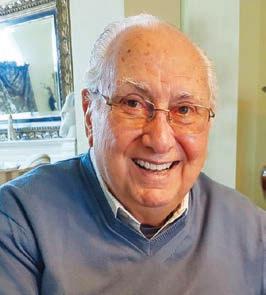
Worcester County, population 54,171, is made up of four municipalities in Maryland’s lower eastern shore: Snow hill, Berlin, Pocomoke City, Ocean City. This is my description of little America.
A strip of land dear and deer to my heart, founded and dedicated for centuries by pioneers who tilled its soil, raised its food, built its homes, manufactured its products, formed its union, created its education institutions, developed its natural resources to international entertainment centers.
Who is responsible for the changes, growth and development of these natural resources? Who are the
multi-billionaires that bring thousands to live, work, play and pray in the woodlands, on the sands, over the waterways and in the comfort of home. What are their roots to this heavenly creation?
Pioneers. That’s who created this land of pleasant living. Pioneers. Men and women who utilized this flat land to farm crops, raise cattle and earn a meager living.
A farmer set out on this land, growing vegetables and backyard chickens to feed his family and provide the local store with an earned income. One hundred years



By Roger Marino
later, his great-great-grandson is tilling the same soil with unimaginable technology, producing corn for grocery store marketing, growing millions of chickens and shipping them after 7 weeks of growth to plants just a few miles away to then be processed, packaged and sold to America’s chain-store grocers and container-shipped by the hundreds of millions to other countries, feeding people around the world.
A Worcester County pioneer—this great-great-grandfather and the hundreds who followed in his farming footsteps.
A pioneer real estate sales person who grew up in the vicinity of some tall pine trees set his eyes on developing some of these 9,000 acres of wet pinelands. One by one, lot by lot, he built and sold homes on this could-be parkland and did so at the risk of his own economic disaster. Who would have believed these 9,000 acres of thick woodland, situated on the Ocean City shore, would someday become a city of 12,000 active citizens? A pioneer would. A pioneer who would sacrifice his family’s financial future on the potential growth of today’s healthy home-sites.
Today, that sales person hangs a shield of honor in front of his pinelands business, still advocating the advantages to living on this Worcester County ground and growing the land with new housing.
Then there is the commercial fisherman, whose family has spent generations riding the waves on the Atlantic Ocean, looking for the richest catch and delivering the best one of the day to restaurants, visitors to the island and a world beyond this habitat. A man, a boat and his family, risking their lives daily to earn a living on their vessel of commercialism. A man, like the generations before him, pioneering the waterways to satisfy his family, with the catch of the day.
Let us not forget the pioneering spirit of the lady who came to the
Pines with the spirit and desire for a healthy retirement. But shortly after, the spirit became eager, wanting to contribute more to her community than just a few hours of volunteer work each week. What to do with this energy and enthusiasm, combined with many years of technical knowledge, stirred within her a thirst to gather news and relate it to those with whom she lived. Thus developed the realization to create a local newspaper, filling it with educated words on lineage, telling the news of the day, and displaying pages of social entertainment to a community she quickly began to love.
We all know you get nothing free in this society. Our pioneer launched into this world of prose with the enthusiasm of a tiger. Reaching into her retirement finances with the spirit of a ballcarrier on the final play in the last quarter of the Super Bowl, his team behind three points and the goal two yards away. With stamina, willpower and help from the community behind him, victory was soon in his grasp.
This pioneer woman, launched into the front line with grit, stamina and willpower on a mission to provide her neighborhood with something she felt was sorely lacking, needed and worthwhile. The pioneer spirit. An internal possession known only to successful entrepreneurs, people willing to take a risk and put it all on the line for the right to say it is done. A human being with the entrepreneur spirit to deliver this paper, an ink baby, at all human cost to a public eager to read and appreciate the messages within its pages.
Written here are the descriptions of only a very few pioneering persons of all colors, sizes and shapes, male and female, who battled hurricanes, flooding, droughts, with insight, foresight, enthusiasm and the determination to create cultural, educational, entertainment, agricultural/technical genius from the godly attributes in our fertile land, sea and air.
By Giovanni Guido Staff Writer
Peaches of every shape, size and form decorated the lawn of the Taylor House Museum for the Town of Berlin’s 17th annual Peach Festival. From roughly 10 a.m. to 3 p.m. last Saturday, the museum hosted multiple peach-themed contests, music concerts and children’s activities, all while roughly 25 vendors provided peach-related food and drinks for the event.
When selecting the vendors to be featured at the festival, the museum focused on both nonprofits and local businesses, according to the museum’s executive director, Melissa Reid.
Nonprofits like Buckingham Presbyterian Church had peach pies for sale, Chesapeake Bay Farms sold peach ice cream, Buckingham Elementary School was selling baked goods, Germantown School sold hamburgers and hot dogs, and many other vendors were present, selling their products. Additionally, local business Baked Dessert Cafe provided peach dumplings, which was named the official town dessert not too long ago.
Both this event and the designation of the peach dumpling as the official town dessert commemorate Berlin’s long history with peaches.
“From about the 1890s through about the 1940s, Berlin, Md. was the location of the Harrison Orchard, and at one point, they were the largest fruit mail-order orchard company in the world, actually. And so, about 1910, they did have what they called a Peach Festival on the lawn of the house called
Windy Brow, which was where the Harrisons’ main house was,” Reid explained.
Berlin’s peach production was to such an extent that the town ended up getting itself named the “Peach Capital of the World.”
The town’s peach industry did eventually fade, however, in the 1960s, when disease swept over the orchard fields, snuffing out its immense productivity. And with it, the Peach Festival also faded. It was not until nearly a century after its first occurrence that the Peach Festival would once again return to the world’s former “Peach Capital.”
“We have a photograph in the Taylor House Museum archives of that Peach Festival … Our former curator, a woman named Susan Taylor, about 20 years ago, was going through our archives and came across that photograph. So, it was her idea to start the Peach Festival in Berlin, and we’ve been doing it ever since,” Reid said.
For the event, the museum put together multiple contests for attendees to participate in, including both a children’s and adults’ pie eating contest, a peach pit guessing contest and a peach pie baking contest.
For the peach pit guessing contest, there was a jar full of peach pits at the event’s welcome table for people to give their best attempts at guessing the correct number of pits in the jar. The person closest to the correct answer would be declared the winner.
The peach pie baking contest had 12 participants, each an amateur home baker, who created their own
See PEACH FESTIVAL page 15





By Giovanni Guido Staff Writer
On Sunday, Aug. 10, five local chefs will be given the chance to win a “Golden Ticket” to the World Food Championship, an international cooking competition. To earn this opportunity, they will have to put their cooking skills to the test at the Maryland Farmers Market Chefs Challenge.
Although similar events have been held all across Maryland, giving chefs from other cities and towns a chance to win a ticket to the international contest, it is the first time this culinary showdown will be held in Berlin.
According to Allison Early, the administrative assistant of Berlin’s Economic and Community Development department, the event will be held on Main Street during the Berlin Farmers Market and will begin at 9 a.m., the same time the market starts. With cooking set to begin at 10 a.m., the participants will have only one hour to prepare their dishes before the judging commences at
11 a.m. The winner will then be announced at noon and the event wraps up at 1 p.m.
For the competition, the participants will have to make two plates of one dish, the dish being decided on the day. They are allowed to bring their own ingredients; however, they must incorporate three ingredients and one protein procured from the farmers market in the chosen dish. Early explained that those ingredients could be anything from oil to vinegar, tomatoes to onions, even beer to rum. And there is no shortage of protein options for the participants to choose from, she added.
“They only get a certain amount of time to do that, and then they’ll go to their stations, and they’ll all cook at the same time. And then they cook two dishes of the same dish. One is left out on display so that the market can see what the chefs have made, and the other is taken by the judges … They will take that in somewhere and judge it privately. And then the winner will be announced,” Early said.
The five chefs that are going head-to-head in order to win are all from local restaurants in the Town of Berlin: Justine Zegna from Blacksmith, Toby Gilbert from Gilbert’s Provisions, Yancey Caripico from The Cap’ns Slice, Cherrise “Reese” Graham from Forgotten 50 Distilling and Josh Morrison from Roadie Joe’s Berlin.
The World Food Championships, which the five chefs are all competing for a chance to participate in, is one of the largest competitions in food sports, according to the website of the Restaurant Association of Maryland. Early said the international competition is often where big TV cooking networks will scout new chefs to bring onto those shows to compete. It is also a great opportunity for chefs and their respective restaurants to gain wide recognition. This year marks the 13th annual championships, which will take place at the Indiana State Fairgrounds & Event Center in Indianapolis from Oct. 16 to 19.
A state partner of the World Food Championships, the Restaurant
Association of Maryland is putting together this event with the help of Maryland’s Best, Maryland Department of Agriculture and, of course, the Town of Berlin.
Early believes the association chose to host the event in Berlin and provide local chefs this opportunity because of the reputation of the town’s farmers market.
“The Berlin Farmers Market has a really good reputation and a lot of food to offer. There’s a lot of farmers markets that have a lot of arts and crafts, which is fine, but we are a producers-only market. So, we do provide a lot of food options. And maybe that was a big part of it. We have become a culinary destination, with all the restaurants we have in town,” she said.
Town residents and tourists who attend the Berlin Farmers Market on Sunday, Aug. 10, will be able to watch as the five chefs do their utmost to win and see the judges make their final decision for who will get that “Golden Ticket” to the World Food Championships.

By ROC Edition Staff
Bocce ball, a bowling sport dating back millennia, appeared in Ocean Pines as an amenity earlier this year. With courts at the Yacht Club and White Horse Park, the physical activity is being received with enthusiasm by both league players and casual players.
Having witnessed firsthand the great excitement around this new amenity, Director of the Bocce Ball League Michael Galello spoke of the massive turnout.
“There’s positive feedback for a couple of reasons. Number one: social reasons. People love making new friends. The second reason is that there are physical limitations to other activities, such as playing pickleball, bowling, whatever. So, this is an activity that seriously anyone can play,” the director said.
The two courts at the Ocean Pines Yacht Club, where Galello volunteers, are specifically designed for league play. In accordance with the US Bocce Federation, the league courts are 76 feet long by 13 feet wide and, as a welcome addition, have professionally-installed synthetic turfs, perforated to allow for the drainage of water. For the games, league players are provided with 2-pound bocce balls, as are standard for competitions.
But the fun isn’t just for people who regularly score four points in a single round. Beginner players who are not part of the league can also play at the courts, according to Galello. Currently, the league plays every Thursday, Friday and Sunday, from 4 to 9:30 p.m, so that the public can enjoy the bocce experience outside of those designated times, provided they bring their own balls. Even if you have an urge for a bocce game in those time slots, though, the bocce court
Continued from page 13
respective peach pie at home and brought it to the festival to then be scrutinized by three judges.
Reid said the museum awarded prizes to the individual winners of all three of these contests. For the children’s peach pie eating contest, the winner received a gift card for On Thin Ice, a recently-opened shop that sells icy snowball treats. For the adults’ peach pie eating contest, a Peach Festival t-shirt was given to the winner. As for the peach pit
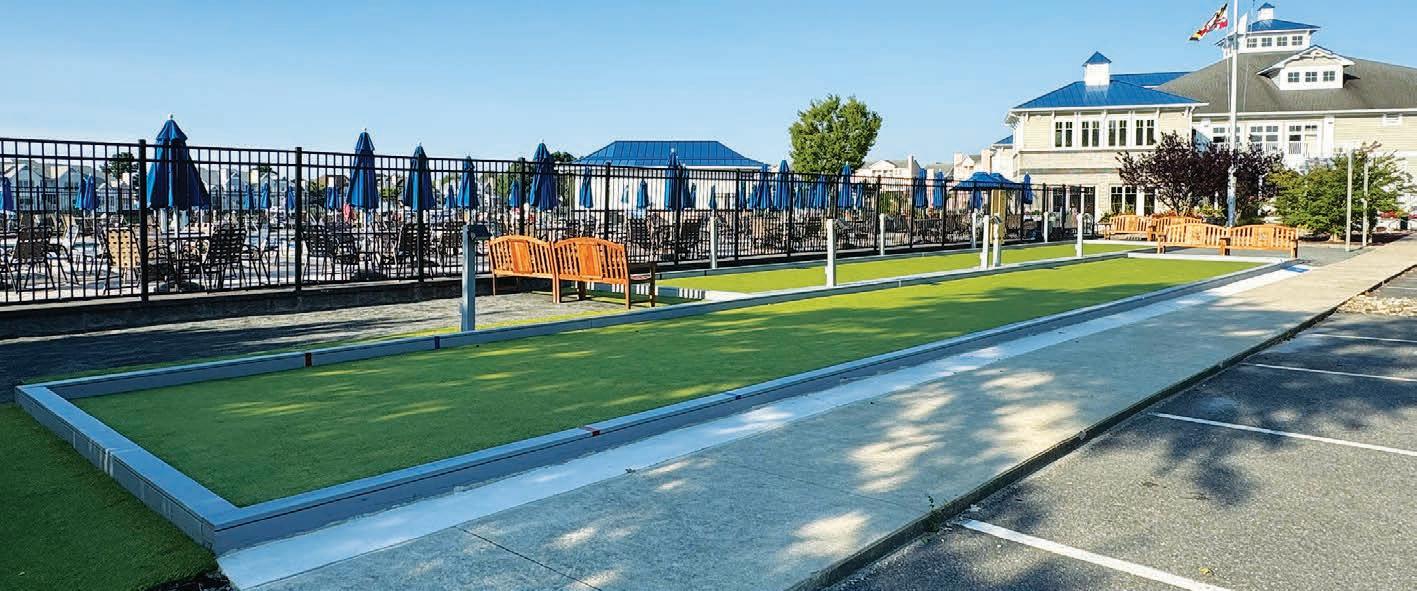
ROC Edition • Sherrie Clifford, Publisher
Players gather at Ocean Pines Yacht Club’s bocce courts as attendance and community enthusiasm around this amenity continues to grow. The courts host league matches three days a week in designated time slots, outside of which, the public may play.
located at White Horse Park, with its cinder surface and smaller dimensions, is always open and specifically designed for beginners of the sport.
Although the rules, court sizes and surfaces of the game are largely standardized now, it took thousands of years to get it to where it is today. The director compared its evolution to the Italian wine, Chianti: It started off with many variations, having no fixed recipe. The wine would be different from region to region and town to town, but all still under the general name, Chainti. As time went on, however, standardized procedures were developed, leading to today’s well-known red wine. Or, in the bocce’s case, today’s wellknown game.
Those who missed the admission period for the current league season have a chance to sign up
guessing contest, the winner was also awarded a gift card to On Thin Ice. And, finally, the peach pie baking contest awarded the first, second and third place winners. First place won a dinner to a local restaurant and second and third place both received gift bags of town-related goodies.
There were also a couple children’s activities scheduled during the event. A magician named Magic Jack Noel held a magic show for the children who attended. Also for the children, the museum held two storytime activities, where children

for the upcoming one. There is a summer league, fall league and spring league. Each person joining must pay a fee of $25 to register as a league player. Substitutes need to register but do not pay any fee. All bocce lovers, not just in Ocean Pines, are encouraged to register. The fees pay for maintenance and other overhead costs of the bocce courts.
With a large number of applicants expected for the fall league, the days of play are likely to be changed to Thursday, Friday, Sunday and Monday.
Although Ocean Pines is currently one of the only locations in the area
got to listen to someone read a story. In addition to these two activities, Buckingham Elementary School and the town put out different games and activities for children.
Throughout the day, the musical duo that has been featured at the Peach Festival for many years now, the Bilenki Duo, performed a wide variety of songs. Alongside the Bilenki Duo, the local band Berlin Airlift performed at the festival for the first time, playing a mix of blues and rock.
With the museum selling bags of peaches, peach drinks, Peach Festival
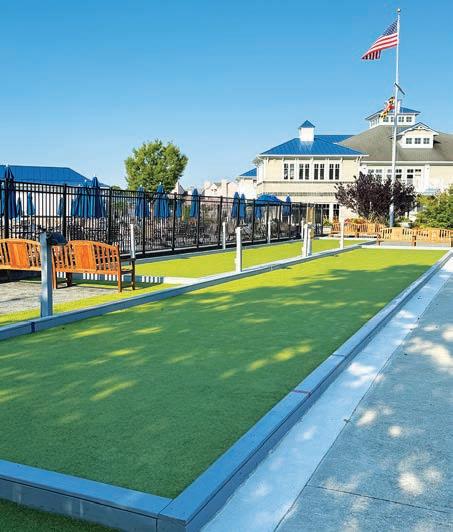
for league competitions, this is just the beginning. And the mission is by no measure small.
“The long term goal is to get other communities involved and interested in bocce ball so that they have courts … I really feel that we can develop an eastern shore bocce ball league. That’s our goal,” Galello said.
For more information on the upcoming league and registration process, contact Director of the Bocce Ball League Michael Galello at 410-430-8491 or via email at mgalello@aol.com.
t-shirts and having its gift shop open for attendees, this festival doubles as a fundraiser for the museum, with all the proceeds going toward the museum. Reid stated that the festival typically brings in around 3,000 people, making it the museum’s largest fundraising event.
“What’s great about Berlin now is that it does have a lot of street festivals, but the Peach Festival … is still by far the largest event in Berlin … We’re so glad that we’ve pulled people from all over the place for the Peach Festival, locals and tourists alike, which is great.”
